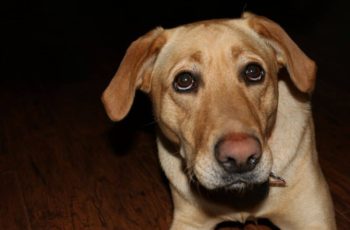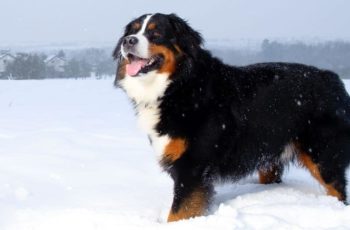This post may contain affiliate links. We may earn money or products from the companies mentioned in this post.
When starting to train your dog, it is important to try out different types of reinforcements to see what they enjoy the most.
There are three main ways to motivate your dog to want to learn a desired behavior. One is toys, another is attention, and the most widely used is treats.
The most popular and effective form of training is called positive reinforcement. This means giving your dog something they like when they do the correct behavior in the hope they will do it again. Most often, this is when a food reward is given.
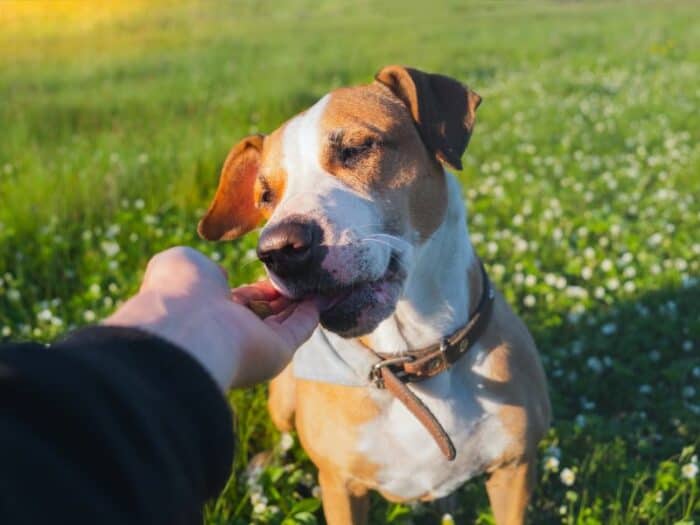
Food can also be paired with a “clicker” which makes a sound to alert the dog they have done the right behavior and something special is coming their way.
Colby, who trains service dogs, uses a clicker with his puppies from the very start of his training with his puppies.
Different types of reinforcements:
Another reason there is so much success with using food for rewarding your dog is that it is a “primary reinforcer”.
This means it is something animals need to survive so it has inherent value such as food, water and shelter.
A “secondary reinforcement” is more along the lines of using the clicker or praise when training followed by the treat.
The click or praise itself becomes a type of reward and lets the dog know they are doing the correct behavior.
It can also be effective because it becomes associated with the primary reinforcement.
I have a dog in training now named Nikki who loves working when she sees the clicker and is happy to work for the click sound even without treats always being given.
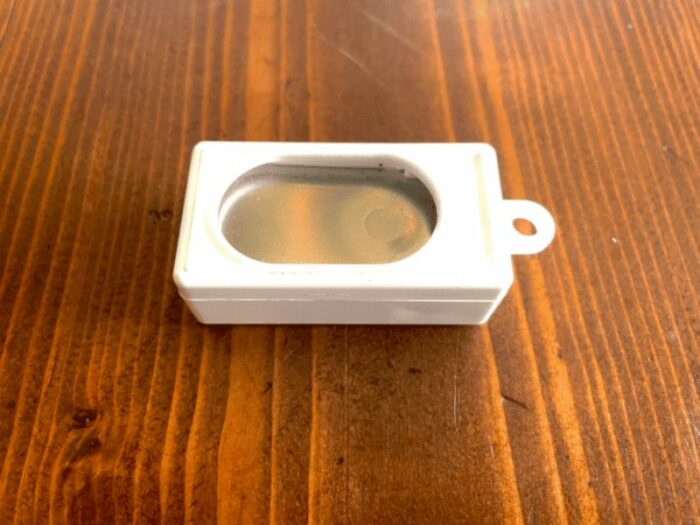
Categorizing treats based on value:
The word “value” is used to rate the type of treat you are using. When we begin to train a behavior with our dogs, we choose a treat that matches the level of difficulty of the behavior we are trying to teach.
Believe it or not, there is a hierarchy of treats and it is important to know which types of treats to use.
There are three ways in which I categorize treats:
Let’s begin with the low value or low reward treat.
This would be something your dog is used to and although they will still work to get the treat, the motivation will be less and you might not be able to hold their interest for very long.
If the behavior is difficult for them, the low value treat may not be worth their effort.
Some examples:
- Kibble
- Plain chicken
- Dog biscuits
There is a place and time to use these treats successfully in your training.
You don’t need to give your dog a high value treat every time you reward them or your high value treats will lose their appeal.
A low value treat is great to use when you are rewarding for a behavior they already know.
A medium value treat is something slightly more special that their normal food.
Choose something your dog likes and you can give to them throughout the day for good behavior.
Some examples:
These types of treats are used more frequently in your everyday routines.
It’s nice to have this option when you are trying to maintain an already learned behavior or there are slight distractions while you are training so you can keep their interest and attention.
A high value dog treat is when you are pulling out all the special goodies. These types of treats are not what your dog gets on a routine basis.
Some examples:
These treats are used when we are training a brand new behavior or a difficult behavior and you want to keep your dog’s interest.
It is also a good time to use these types of treats if you are in a highly distracting environment.
I like to use high value treats when I am working on behavior modification to stop unwanted behavior such as pulling on the leash, jumping, anxiety or even aggression.
How to use treats when training:
When I start training a dog, I like to use a “clicker” which we mentioned above.
A clicker is classified as a “conditioned reinforcer” which means it is a neutral stimulus that gets paired with a primary reinforcer to become a bridge to tell the dog it has done something correct.
I teach this because it enables me to tell my dog it has done the right behavior without having to get a treat every time.
The click sound tells the dog that if it continues that behavior, it is going to get something it likes and wants.
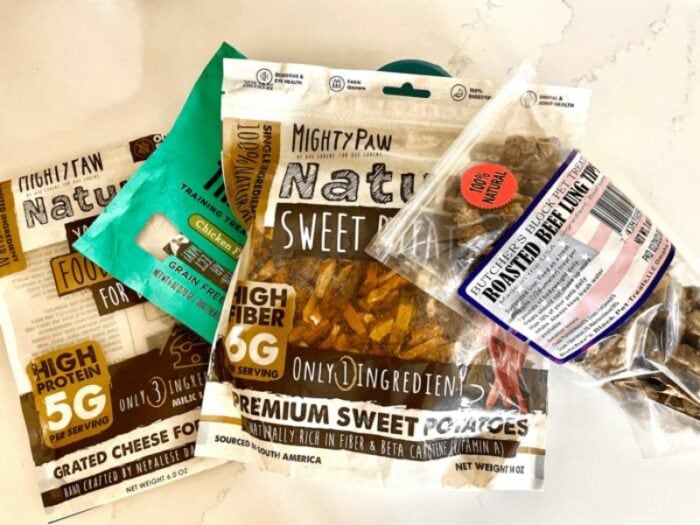
Step 1: Use the right treat for the job
Decide what behavior you are going to work on and how difficult you think this behavior and the situation is for your particular dog.
This means deciding what value of dog treats you are going to need.
When deciding what to use, it is important to be aware of what your dog enjoys. Some dogs like dry treats while others like something a little more exciting like bacon.
I also have dogs that would prefer to have a toy as a reward or physical touch.
Step 2: Pairing your treat with the clicker
I use a clicker with my dogs to help them understand they have done the right behavior at the right time.
To do this, we have to shape the behavior we want and then reward the dog at the exact moment they do it.
As an example, we can use training our dog to sit. There are many ways to do this but for this purpose we will have the dog stand at our side.
Hold your leash in your hand, tell your dog to sit with a voice command and a hand que. When the dog sits, click the clicker and give him a treat.
Repeat this multiple times, rewarding the dog with the clicker and the treat paired together.
PRO TRAINER TIP: When telling your dog to sit, put them on your left side as if they were heeling. If the dog does not sit when you give the command, run your hand with light pressure down the dog’s back while giving the command and lifting up on the leash slightly. When the dog sits, click and give a treat at the same time.
Step 3: Advancing your training using treats
Now that the dog is learning that the treat and the clicker are paired together, you can move forward with your training and take on more difficult tasks.
To advance a behavior means to move from a simple behavior, such as the sit described above, to something more difficult that will include the sit command.
An example of this would be the down command.
The down command is often taught when the dog is already in a sit position.
Because the dog already knows the sit command, you don’t want to have to reward them for it every time you repeat the process.
This is where the clicker can come in handy. When you have them sit, you can click the clicker, without giving the treat and the dog still knows they have done the right behavior.
Then you can focus on the down command and give the treats for that behavior.
PRO TRAINER TIP: As you are working through teaching your down command and having the dog sit first, you might notice they lose some excitement about sitting. If this happens, simply click and reward them with a special treat the next time you tell them and this should revive their interest.
Distractions:
I use high value treats when I train a dog in a busy environment or one that may cause them to lose focus.
I like to use something small in size that I can use quite a bit of that they really like. This pulls their attention back to me and mutes the outside noise.
Supplies we Recommend:
Rapid Fire Questions:
Is it alright to use food as a reward and will I then always have to use food?
Yes, food is a great way to motivate your dog if that works for them. Choose foods that are something they enjoy and are healthy for them.
I also have clients who will portion out their regular dog food and use that in their training session if they worry they are feeding their dog too much.
No, the goal is be able to work your dog in the real world without always having something yummy in your pocket.
The treat is a way to get your dog to enjoy working and to be motivated to learn a behavior they don’t know.
As we talked about above, once the dog knows the behavior, we give them treats intermittently and add in our corrections to be able to wean away from always having to give a food reward. It is not necessary to phase out treats completely as rewards.
Why does my dog only listen to me when I have treats?
It is important to move from training sessions into the real world and use what we are teaching our dogs in real life situations.
It is useful to find out different ways your dog enjoys being rewarded as well, such as a toy, physical touch or being rewarded verbally.
Your dog should look at all moments as training moments where they could be reinforced at any time.
Your dog should not think that they are only working when they are in a training session and free to misbehave when they are out in the world.
To accomplish this, it is best to always have something to reward your dog with and to keep treats out of your hands when you are in training sessions.
This is also why other types of reinforcements are important to have.
Final thoughts:
I have a lot of clients who worry about using treats to train their dogs for various reasons.
Some think the dog will get fat while others think the dog will never listen to them if they don’t have treats handy.
These assumptions are simply not true if you follow the steps I have given you. In short, it is important to use what you have trained out in the world as soon as you can and feel confident your dog knows it.
Have multiple ways of rewarding your dog and use the right type of reward for the behavior you are working.
It is also possible to use a portion of your dog’s daily food if the fear is that your dog will gain weight.
What types of treats have you had success with when training your dog?
Have you ever tried to use a clicker with our dog and was it successful?
What other types of rewards have you found helpful to use with your dog?
I hope this has given you some helpful tips to use when training your dog. Now go out and enjoy your dog!
Save To Pinterest
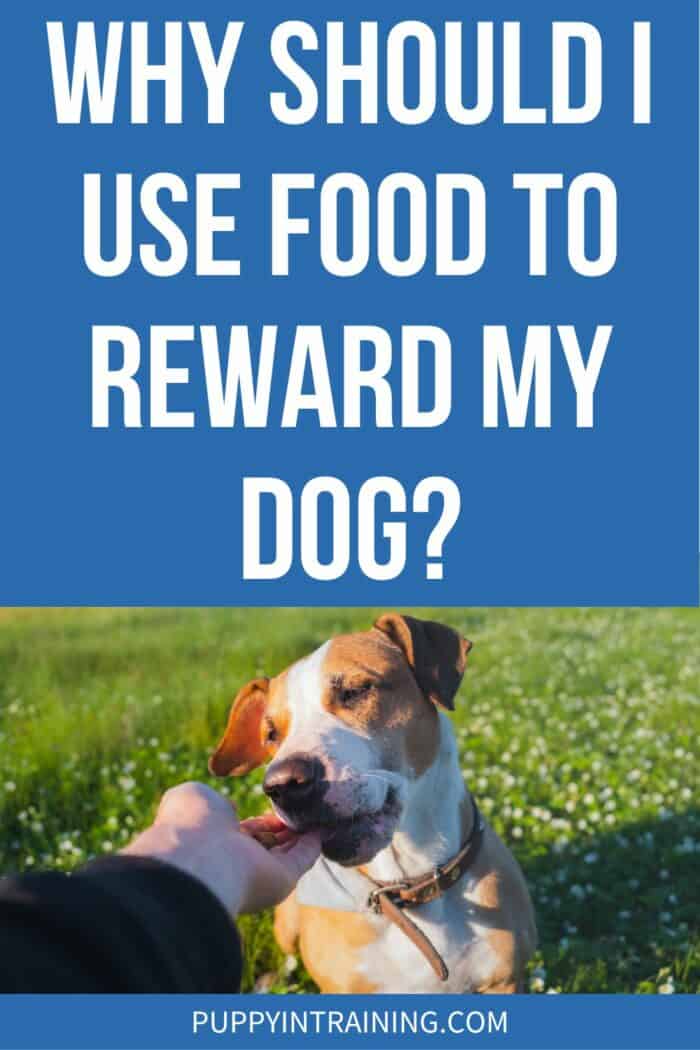
Top Picks For Our Puppies
- BEST PUPPY TOY
We Like: Calmeroos Puppy Toy w/ Heartbeat and Heat Packs – Perfect for new puppies. Helps ease anxiety in their new home. - BEST DOG CHEW
We Like: Mighty Paw Naturals Bully Sticks – All of our puppies love to bite, nip, and chew. We love using Bully Sticks to help divert these unwanted behaviors. - BEST DOG TREATS
We Like: Crazy Dog Train-Me Treats – We use these as our high-value treats for our guide dog puppies. - BEST FRESH DOG FOOD
We Like: The Farmer’s Dog – A couple months ago we started feeding Raven fresh dog food and she loves it! Get 50% off your first order of The Farmer’s Dog.
Check out more of our favorites on our New Puppy Checklist.

